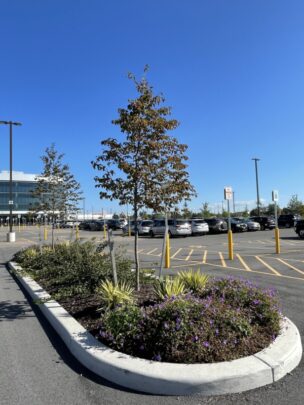The new UR Medicine Orthopaedics and Physical Performance Center, located at Marketplace Mall, has kept sustainability in mind since day one of the building process. As it currently stands, this new center is slated to receive LEED Certified status at the minimum, with plans to achieve LEED Silver and possibly Gold. LEED is a rating system created by the U.S. Green Building Council to recognize construction and renovations that increase the environmentally sustainable integrity of a building.
Green energy
 Principal architect Scott Hansche shared that the University was looking into placing photovoltaic (PV) panels on the upper portion of the building’s roof, which would push the LEED certification into the Silver category. Evangelos Yannas, Director of Special Projects at URMC, confirmed that they do have plans to install solar panels, which will offset 25% of the building’s energy consumption. There is also a row of electric vehicle charging stations in the parking lot, with plans to add even more.
Principal architect Scott Hansche shared that the University was looking into placing photovoltaic (PV) panels on the upper portion of the building’s roof, which would push the LEED certification into the Silver category. Evangelos Yannas, Director of Special Projects at URMC, confirmed that they do have plans to install solar panels, which will offset 25% of the building’s energy consumption. There is also a row of electric vehicle charging stations in the parking lot, with plans to add even more.
In terms of energy savings, the building has gone through enhanced commissioning to “make sure all the systems operate to their expected value, which actually saves energy,” Hansche explained. The building is fitted with occupancy sensors and can trigger changes based on how many people are in a room. This could include turning lights on or off or even reducing airflow to certain parts of the building.
Other sustainable measures

The sustainability of the Center doesn’t stop there. Hansche listed out many other sustainability measures they’ve taken:
- Reductions in light pollution
- Reduction of both indoor and outdoor water usage
- Use of local and regional construction materials
- Heightened indoor air quality
The many flower- and tree-filled islands in the parking lot are not just for decoration – they actually help soak up rainwater, decreasing surface runoff from the parking lot. Yannas explained that the University had worked with the Town of Henrietta’s planning and design boards to make sure their stormwater systems would not disrupt the nearby natural ecosystem or overwhelm the stormwater retention ponds on site.
The importance of location
The UR Medicine Orthopaedics and Physical Performance Center is built on the site of the former Sears anchor store, which closed three years ago. Integrating medical buildings into underutilized mall space is not a new concept; the University took inspiration from Vanderbilt which repurposed 450,000 square feet of a nearby mall into a bustling medical center. “There’s a lot of value in reusing the existing infrastructure,” Yannas stated, citing the usefulness and sustainability of building on an already developed parcel of land. From a sustainability standpoint, it meant that no additional nature spaces had to be destroyed. There was already a large parking lot, necessary for the amount of staff and patients coming to the building every day. There’s easy access to the site by car not only within Rochester, but within the whole region as it is located close to an exit from I-390, which is linked to I-90. There is also a bus stop close to the entrance, serviced by the 14 and 41 bus routes, along with RTS on Demand. Even before Marketplace Mall itself was built in the 1980s, Yannas shared that it used to be home to an airport, with the construction team finding pieces of a runway below the ground.
The new construction was welcomed by the Town of Henrietta government, with town supervisor Steve Schultz anticipating the center will help revitalize the mall and surrounding area, which has been plagued with vacant storefronts. Already he’s seen improvement with new food court tenants, the construction of Marketplace Senior Apartments on the same property, and a “major coffee franchise” has expressed interest in opening a drive-thru across the street from the mall in the former Pizzeria Uno.
“It’s revitalizing a whole part of the community of Henrietta,” added Matt Nelson, the architect working with Hansche and Yannas. “It helps reduce city sprawl if we were to continue to build more and more further away from the city center. This is going to change everything.”
Written by Sarah Woodams ‘24(T5)
Photos provided by Sarah Woodams / University of Rochester

